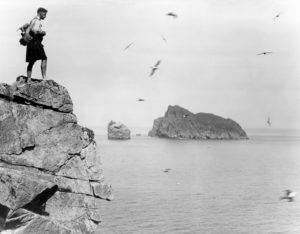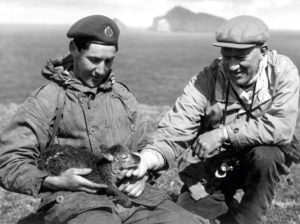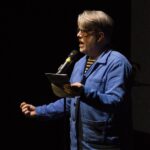A tribute to one of the most dynamic, enduring and intriguing islands of Scotland
This island represents an enigmatic and awe-inspiring landscape, a starkly beautiful vision of ‘life on the edge’ which has fascinated everyone from travellers, antiquarians and conservationists to writers, film crews and tourists. And, perhaps as a result, it is one of the most mythologised and misunderstood places on earth. In this new book, archaeologists Angela Gannon and George Geddes turn the popular perception of the archipelago on its head to tell a compelling story of triumph over geographical adversity.
Extract from St. Kilda: The Last and Outmost Island
By Angela Gannon and George Geddes
Published by RCHAMS
The first travellers to St. Kilda must have prepared carefully for their trip across the daunting Atlantic waters, readying their boat, gathering food and fuel, and looking out for good weather conditions.
In the 17th and 18th centuries, the journeys made by the islands’ tacksman were sometimes transformed into battles for survival – in one case during the 1690s, tacksman Alexander MacLeod and his party were blown off course by some 200km to the island of North Rona, where they were forced to spend the winter. For the St. Kildans themselves, careful preparation and good weather were prerequisites for visits to the outlying islands and stacks; even the closest island of Dun presented a significant and treacherous challenge, three men drowning there in 1909. A sense of danger and adventure has been at the heart of visitor and islander experience on St. Kilda since the very beginning. There is little doubt, however, that the evacuation encouraged intrepid scientists, who were more than happy to take on the challenge of living and working on the archipelago without help from anyone else. The 1931 St. Kilda expedition, made up of students from Oxford and Cambridge Universities, and led by ‘one of the foremost scientists of his generation’, David Lack, was a defining example. Visitors after the evacuation also included Robert Atkinson, whose Island Going ranks among the best of all Hebridean travel books. Atkinson and his companion John Ainslie began their island adventure in 1935 with a trip to Handa, driving up in Atkinson’s mother’s car. His interest went beyond ornithology and his photographs, now held at the School of Scottish Studies, form a unique record of St. Kilda’s archaeology and architecture.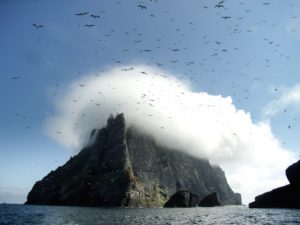
Combining the close study of natural history with a more general description of the islands they visited, Lack and Atkinson paved the way for scientists like John Morton Boyd, for whom St. Kilda would be a rite of passage on his way to becoming the Head of the Nature Conservancy. In 1969, Boyd described how ‘St. Kilda has always been a great event for me. My first visit to the islands in 1952 was my breaking clear of a life where mediocrity provided enough incentive for mediocre achievement. St. Kilda has been my emblem of endeavours and I swear that if I were ever to make recognition of one place as having influenced me more than another, I would not choose Canada or Africa or Britain, but St. Kilda.’ The opportunity to combine adventure with conservation was opened up to a wider community in 1958 when the first of the National Trust for Scotland (NTS) work parties came to the island, a tradition that has continued to this day.
The volunteers, many of whom have returned time and again, were behind the creation of the St. Kilda Club in 1976, and the periodical the St. Kilda Mail, whose first edition described how for ‘those who prefer a challenging, strenuous but very satisfying vacation, a visit to St. Kilda … is surely a must’. In that same issue, the warden, George Wood, wrote of how ‘early in May Dr Mike Harris and Stewart [sic] Murray were engaged on a Puffin study and swinging across the Breaches Buoy with them I enjoyed two wonderful days on Dun’. Stuart Murray first came to St. Kilda in 1974 and in a few short years he had taken every opportunity to explore the archipelago, reaching all of the outer islands and stacks. Stuart’s abilities as a guide and climber were to have a great influence on the survey begun by Mary Harman in 1977. His contribution was no less important to the work of the Royal Commission on the Ancient and Historical Monuments of Scotland (RCAHMS) in the 1980s and 2000s, whether on Dun and Boreray, or on islands like North Rona and the Flannans. Our records of archaeological sites on the stacks still rely on the work of Murray and Harman before 1985. In his comprehensive Natural History of St. Kilda John Love was able to venture that ‘no one today … knows St. Kilda as intimately’. For Stuart, Island Going has become a way of life, where adventure and research are interwoven and inextricably linked.
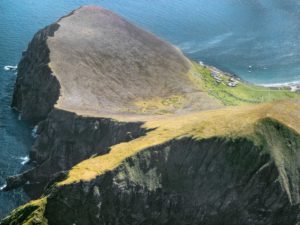 On 26 February 1908, when RCAHMS first met in Edinburgh at 29 St Andrew Square and discussed how they would ‘make an Inventory’, they settled upon a fundamental principle – it was essential that the staff should undertake fieldwork, ‘personally inspecting each monument so as to satisfy your Commissioners as to its true character and condition’. Expeditions to islands became commonplace, beginning with Fidra in the Firth of Forth in 1913 and many of the Outer Hebridean islands between 1914 and 1926. Adventures by boat reached an apex during the survey of Argyll, when the purchase of a dedicated vessel became necessary. In the 1980s, St Kilda presented a unique challenge, through the complications of the survey, and the uncertainties involved in travel to and from the island. Conditions were much more straightforward during the 2007 to 2009 survey, with the facilities offered by the NTS ever-improving.
On 26 February 1908, when RCAHMS first met in Edinburgh at 29 St Andrew Square and discussed how they would ‘make an Inventory’, they settled upon a fundamental principle – it was essential that the staff should undertake fieldwork, ‘personally inspecting each monument so as to satisfy your Commissioners as to its true character and condition’. Expeditions to islands became commonplace, beginning with Fidra in the Firth of Forth in 1913 and many of the Outer Hebridean islands between 1914 and 1926. Adventures by boat reached an apex during the survey of Argyll, when the purchase of a dedicated vessel became necessary. In the 1980s, St Kilda presented a unique challenge, through the complications of the survey, and the uncertainties involved in travel to and from the island. Conditions were much more straightforward during the 2007 to 2009 survey, with the facilities offered by the NTS ever-improving.
Perhaps the only ‘true’ expedition that formed part of this project was the survey of Boreray in 2010. Camping among the Cleitean MacPhaidein, the team endured a storm of terrifying ferocity and witnessed the richest sunsets imaginable while recording in detail the dense archaeological landscape. Three years later, another team set out from Leverburgh at 4am with the express aim of landing on Stac an Àrmainn and recording the incredible evidence of fowling that still survives on its craggy slopes. This was sadly prevented by a tremendous sea swell, which was only appreciated when the boat was within metres of the rocks.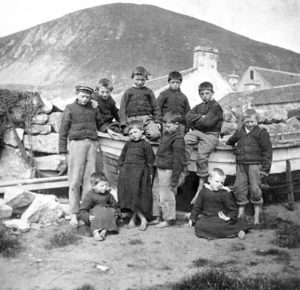
Far more than allowing us to assess the character and condition of St. Kilda’s monuments, our expeditions to the archipelago have provided a remarkable opportunity to understand the nature of living and working on the islands. It has brought into focus what was, for the St. Kildan, an everyday experience. Each day presented different and wildly varying weather conditions, each element of the landscape new challenges in understanding and recording. A few areas also remained out of bounds, whether deemed too dangerous without the help of climbers, or because they are protected as the breeding grounds of important seabird colonies. Some 58 years after its re-occupation, St. Kilda still offers an opportunity for adventure that is unparalleled in the United Kingdom.





